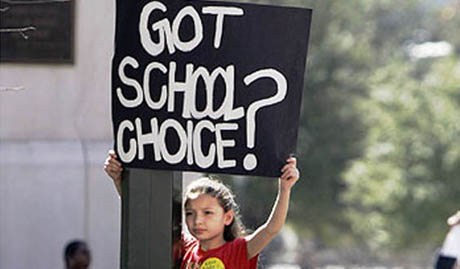Gaslight is a term used by some mental health practitioners to clinically describe a form of prolonged coercive control in abusive relationships. It emanates from the 1944 film Gaslight, in which a woman is systematically driven to believe she is losing her mind so her husband can have her institutionalized. It is also a favorite tactic of the education system – repeatedly twisting reality to make parents believe that administrators are doing right by students.
A recent column in the Topeka Capital-Journal by Kansas Association of School Boards (KASB) Communications Editor Scott Rothschild is a good example of attempted mind control. He writes, “Our state assessment results from tests taken last spring posted the largest increase since the current tests began in 2015. In both reading and math, the percentage of students increased in the top three performance levels and decreased in the lowest level.”
That sounds impressive, and we all wish it to be true, which makes the attempt at mind control more effective. But the KASB statement is a conscious attempt to gaslight.
The table below shows the percentage of students reported in each state assessment category. Levels 3 and 4 both represent proficient performance; students in Level 3 have an effective ability to understand material, whereas those in Level 4 have excellent ability. (The education system denies that Level 1 is below grade level. KSDE originally showed Level 1 as below grade level but now says the assessment only tests grade-level performance, and students in Level 1 have limited ability. The education system wants parents to now believe that every student is at grade level, which is preposterous.)
Not providing hard data is another tactic of those who gaslight. Parents are not supposed to know, for example, that 33% of students are below grade level in math and reading (English Language Arts, or ELA), and only a third are proficient.

Now let’s examine Rothchild’s claim. Positive changes over the prior year are highlighted in yellow, and negative changes are shaded pink. Reducing the percentage of students in Level 1 and increasing the percentage in Levels 2-4 are positive changes. Having more students below grade level and fewer in Levels 2-4 are negative changes.
The claim that 2023 shows the largest gains in reading since 2015 is technically accurate, but only because 2023 is the only year with  improvement. In 2015, 21% of students could not read at grade level, and now it is 33%.
improvement. In 2015, 21% of students could not read at grade level, and now it is 33%.
There was a small 3.1% decline in students who cannot do math at grade level, but it wasn’t the largest improvement since 2015, as alleged; the percentage below grade level declined 3.2% in 2019 after three straight years of declines.
The only accurate statement from KASB is on students in Levels 2-4 in math, where a 1.6% gain is the largest since 2015. But even there, the share of students in that category is much lower than in 2015.
So, there were some minor improvements in 2023, but in every case, it was merely getting back a little bit of what had been lost in prior years. Outcomes before COVID were down from 2015, and now they are lower still.
Gov. Kelly issues her own gaslight statement
Never one to miss an opportunity to gaslight voters, Kansas Governor Laura Kelly issued a statement describing the state assessment results as “vast improvements.”
It is irresponsible yet not surprising for Gov. Kelly to misrepresent student achievement, and she didn’t stop there. She also attributed the tiny gains to “investments in Kansas Public Schools,” which is also more gaslighting from KASB.
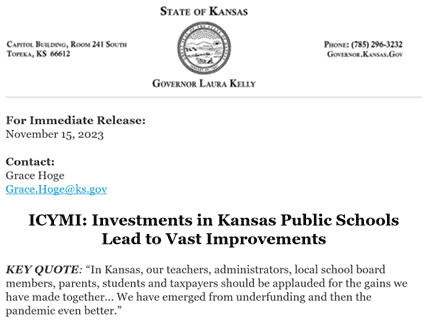
At a recent Special Committee on Education hearing, Rothschild said that school funding “only recently exceeded the rates of inflation.” The truth is that state funding has been above that rate for nearly two decades.
“Kansas funding was below inflation and takes (sic) a real dip from 2009 to 2015,” he said. “Total Kansas funding dropped from 98% of the U.S. average in 2009 to 88% in 2019. Over that period, Kansas NEAP scores fell from above the U.S. average to about the same as the U.S. average. Kansas began increasing school funding more than inflation in 2018 under the 6-year funding plan in response to Gannon, but as you can see we are still below the national average by about 10% and we are just about the regional average.”
Rothschild cherry-picks a short period for his comparison to inflation, coinciding with small funding cuts initiated by former Democratic Governor Mark Parkinson during the 2009-10 recession. School funding has been growing much faster than inflation over the long term, however, as shown below. Per-student funding would have grown from about $9,000 to $13,000 between 2002 and 2022 if just keeping pace with inflation, but actual spending in 2022 was nearly $17,000. The chart also shows that college readiness on the ACT plummeted from 32% to 19% while funding grew rapidly. (2023 spending has not been published at this writing.)
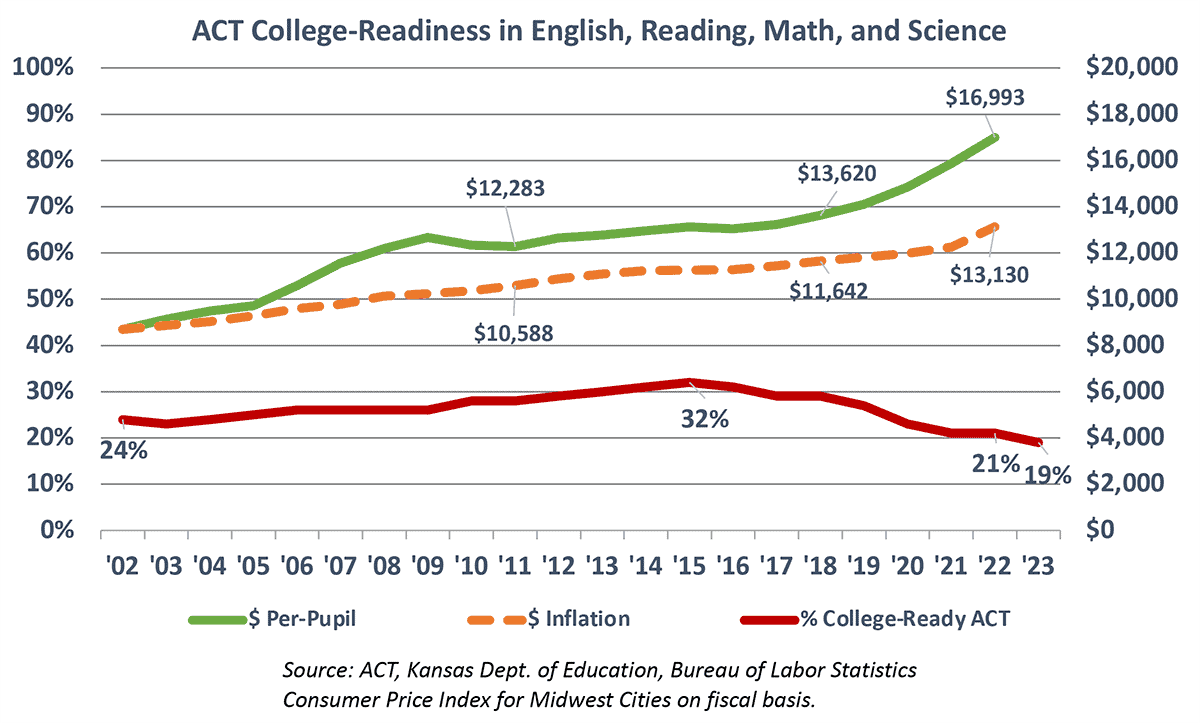
Rothschild also tortures the truth on NAEP score declines and the comparison of Kansas school funding to the national average. He uses 2019 funding numbers instead of the most recently available Census data from 2021. The raw numbers put Kansas at 99.4% of the national 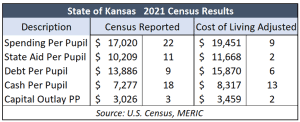 average, but a dollar spent in Kansas buys a lot more than a dollar spent in New York and many other states. Adjusted for the cost of living, Kansas schools spent $19,451 per student, which is 114% of the national average and the ninth highest in the nation.
average, but a dollar spent in Kansas buys a lot more than a dollar spent in New York and many other states. Adjusted for the cost of living, Kansas schools spent $19,451 per student, which is 114% of the national average and the ninth highest in the nation.
KASB and the rest of the education system want parents to believe that schools are always underfunded and that money is the reason for achievement changes, but no research exists that says spending more money causes outcomes to improve.
The chart below shows that reading proficiency on NAEP hovered in the low to mid-30s between 1998 and 2017 and then took a dive. Spending, however, continued to rise but for a small decline during the recession in 2010 and 2011.
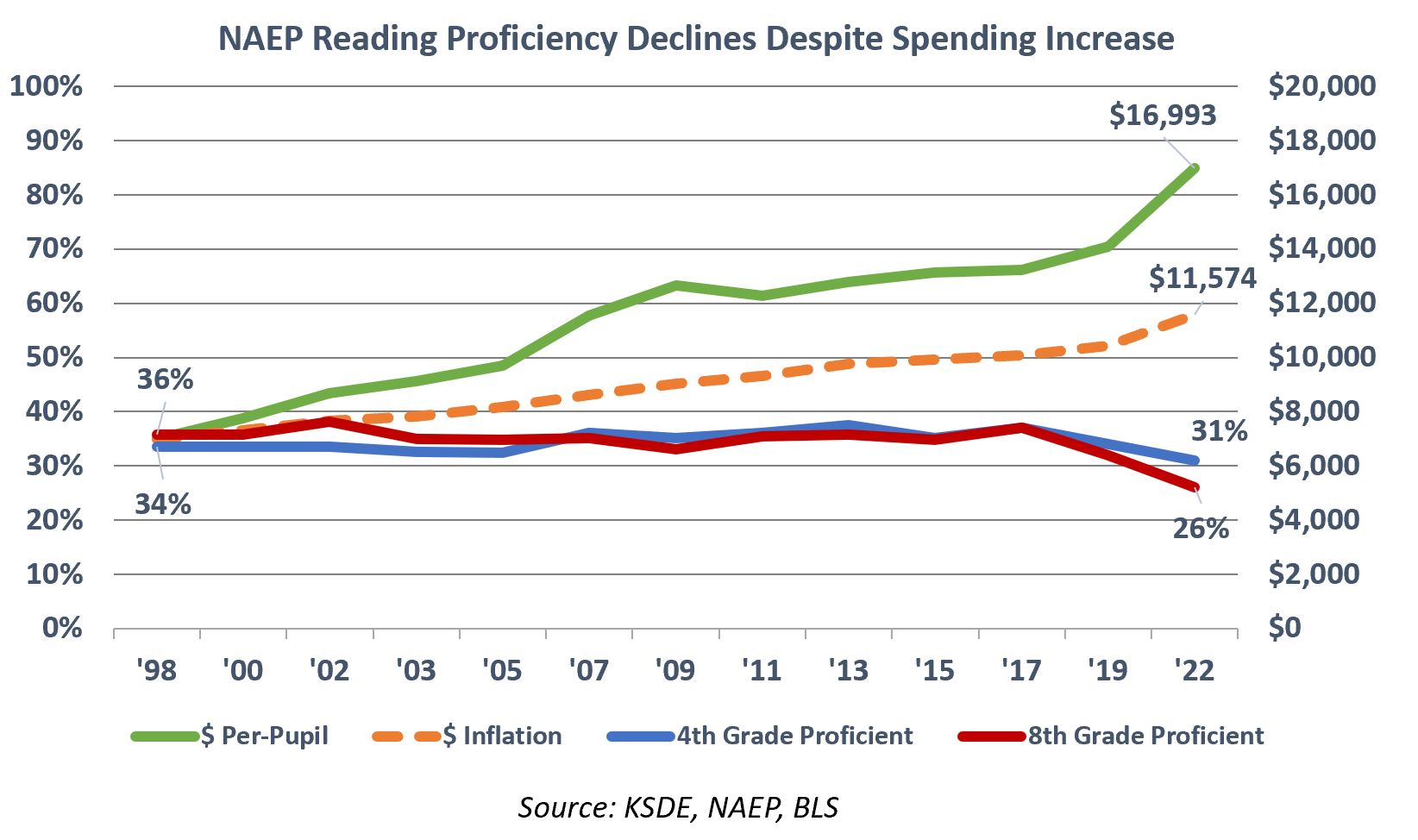
Some students certainly do well in Kansas public schools, but many do not. The education system (KSDE, the State Board of Education, KASB, unions, and administrators) sees the declines, but it would rather gaslight parents than change adult behaviors to help students.
So the Legislature must choose: compel change or accept that about a third of Kansas students will always be unable to read and do math at grade level.



